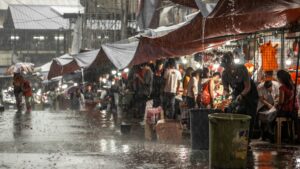OpenCLIM (Open CLimate Impacts Modelling framework) is an integrated assessment framework that brings together existing models for highlighting the impacts of climate change and informing adaptation needs at national and place-based scales.
In its current form, the implications of climate change on agriculture, biodiversity, heat stress, flooding, drought and water supply are considered. It includes changes to urban building density and type, land surface material and biodiversity enhancement. Driving these future changes across these different sectors are the latest UK Shared Socioeconomic Pathways (SSPs) and UK climate scenarios.
Results
Local climate risks
Adaptation inventory

Adaptation examples are modelled within each theme, simulating the impact of options to limit increasing risk, including permeable footpaths, afforestation, surface water storage, changing crop system, and acclimatisation to heat-stress.
The project has supported climate change risk assessments in the Fens region of East Anglia, in Northern Ireland, and the Highland Region of Scotland.
Results
Stakeholders from around the country attended events showcasing our results in London, Edinburgh, and Inverness, between March and June 2023. Results can be accessed from the Data & Analytics Facility for National Infrastructure (DAFNI), where datasets, models and workflows are available, illustrating a range of climate risks consistently at national scale. To help identify datasets of interest, access the inventory of assets available on DAFNI.

Key findings
- Heat-related mortality increases in most areas, particularly in south-eastern England.
- Future warming increases the number and duration of droughts everywhere, particularly in the east.
- Agricultural winners and losers are indicated, with most areas of reduced wheat yield in England and potential gains in Scotland. Investment in adaptation is vital.
- Biodiversity is impacted by each additional increment of warming, with the most resilient refugia at higher altitude in Scotland and Northern England.
- Modest increases to high flows in the north and west, modest decreases in the east. Large interannual variability means extreme events may increase in frequency.
- Natural Flood Management can help manage flood risk in many but not all catchments.
- Developing a consistent framework for the analysis is a substantial effort, but only by working together in a sustained manner can consistency be addressed.
- Socio-economic scenarios are as important as climate scenarios – the UK-SSPs provide explicit and common realisations of the future (e.g. urban development and more widely land use and links to biodiversity) and promote consistency.
- Subnational application of the results adds value and allows consistent views between studies – e.g. Scottish Highlands; Northern Ireland; the Fens.
Local climate risks
Using OpenCLIM national results, we are producing a series of local climate risk reports at county-scale, to assist local stakeholders, such as local authorities, water resource zone managers, or infrastructure operators, to assess the climate risks in their region of interest.
Early released examples can be accessed from the links (PDFs) below:
By mid-2025, examples will be available for all UK Counties summarising risks for Agriculture, Biodiversity, Heat stress, and Hydrology (a proxy for flood or drought risk).

Adaptation inventory
The extent to which adaptation plans and programmes translate into tangible risk-reducing action on the ground, as opposed to adaptive capacity building, remains unclear. The UK Adaptation Inventory aims to address this by documenting adaptation ‘on the ground’, based on national reporting to government by public and private sector organisations and a systematic review of peer-reviewed literature. This analysis informs the national analysis in terms of identifying operational adaptation as distinct from aspirational adaptation.
Legacy
OpenCLIM is an open-access platform to allow ongoing development of the integrated model. This uses the DAFNI platform to ensure a legacy beyond the initially funded period. The objective is to develop a community model where new and improved versions are easily incorporated, and new and emerging science and policy questions can be easily investigated.

As such, future risk and adaptation assessments, including the Climate Change Risk Assessments and the National Adaptation Programme, could be linked to a living science process, drawing on evolving understanding and stakeholder needs.
This would include improving knowledge in the established sectors considered in OpenCLIM, developing better sectoral linkages and interactions, and adding new models of less established sectors and areas as they emerge. This flexibility includes the ability to reframe and pose new questions as they emerge.
Publications
Birkinshaw, S.J., Krivtsov, V. (2022). Evaluating the Effect of the Location and Design of Retention Ponds on Flooding in a Peri-Urban River Catchment. Land, 11(8), 1368. https://doi.org/10.3390/land11081368.
Butters, O., Robson, C., McClean, F., Glenis, V., Virgo, J., Ford, A., Iliadis, C. & Dawson, R. (2025). An Open Framework for Analysing Future Flood Risk in Urban Areas, Environmental Modelling & Software, 185, https://doi.org/10.1016/j.envsoft.2024.106302.
Butters, O., Robson, C., and Smith, B. (2023). OpenCLIM: A national scale framework for evaluating the effects of climate change for socio-economic scenarios and adaptation policies , EGU General Assembly 2023, Vienna, Austria, 24–28 Apr 2023, EGU23-14835, https://doi.org/10.5194/egusphere-egu23-14835.
Jenkins, K., Kennedy-Asser, A., Andrews, O., Lo, Y. T. E (2022) Updated projections of UK heat-related mortality using policy-relevant global warming levels and socio-economic scenarios. Environmental Research Letters. http://iopscience.iop.org/article/10.1088/1748-9326/ac9cf3.
Jenkins, K., Ford, A., Robson. C., Nicholls. R.J. (2022) Identifying adaptation ‘on the ground’: Development of a UK adaptation Inventory. Climate Risk Management, 36. https://doi.org/10.1016/j.crm.2022.100430.
Kennedy-Asser, A.T., Owen, G., Griffith, G.J., Andrews, O., Lo, Y.T.E., Mitchell, D.M., Jenkins, K. Warren, R.F. (2022). Projected risks associated with heat stress in the UK Climate Projections (UKCP18). Environmental Research Letters.
Matthews, B., Hall, J., Batty, M., Blainey, S., Cassidy, N., Choudhary, R., Coca, D., Hallett, S., Harou, J., James, P., Lomax, N., Oliver, P., Sivakumar, A., Tryfonas, T., Varga, L., (2023). DAFNI: a computational platform to support infrastructure systems research, Proceedings of the Institution of Civil Engineers, Smart Infrastructure and Construction, 0, 1-9, https://doi.org/10.1680/jsmic.22.00007.
Nicholls, R.J., Dawson, R.J., Warren, R., Matthews, B., Ford, A., Robson, C., Price, J., Minns, A. (2022). A framework for national risk and adaptation assessments across multiple sectors, AGU Fall Meeting 2022, Chicago, IL, 12-16 December 2022, id. U16B-02. https://ui.adsabs.harvard.edu/abs/2022AGUFM.U16B..02N/abstract.
Redhead, J.W., Brown, M., Price, P., Robinson, E., Nicholls, R.J., Warren, R., and Pywell, R.F., (2025). National Horizon Scanning for Future Crops Under a Changing UK Climate, Climate Resilience and Sustainability, 4, https://doi.org/10.1002/cli2.70007.
Sayers, P., Griffin, A., Lowe, J. et al. Beyond the local climate change uplift – The importance of changes in spatial structure on future fluvial flood risk in Great Britain. Nat Hazards 120, 3773–3798 (2024). https://doi.org/10.1007/s11069-023-06350-x.
Smith, B., Lewis, E., and Birkinshaw, S. (2023). National Hydrological Modelling of Climate Adaptation Impacts for the UK, EGU General Assembly 2023, Vienna, Austria, 24–28 Apr 2023, EGU23-15606, https://doi.org/10.5194/egusphere-egu23-15606.
Smith BA, Birkinshaw SJ, Lewis E, McGrady E and Sayers P (2024) Physically-based modelling of UK river flows under climate change. Front. Water 6:1468855. doi: 10.3389/frwa.2024.1468855
Related pages
DAFNI (Data & Analytics Facility for National Infrastructure) https://www.dafni.ac.uk/
Inventory of public assets uploaded to DAFNI
Jenkins, K., Ford, A., Robson. C., Nicholls. R.J. (2022) UK Adaptation Inventory (version 1). Available at: https://www.nismod.ac.uk/openclim/adaptation_inventory.
UK heat stress vulnerability shiny app https://akaresearch.shinyapps.io/heatstressvulnerability
Videos
OpenCLIM project overview by Robert Nicholls, DAFNI webinar series, 28 February 2024.
A hotter drier UK, Robert Nicholls’ talk from the OpenCLIM London Showcase, 29 March 2023.
A focus on flooding, Paul Sayers’ talk from the OpenCLIM London Showcase, 29 March 2023.
Project partners
University of East Anglia, Newcastle University, University of Bristol, UK Centre for Ecology & Hydrology, Science & Technology Facilities Council, Sayers & Partners.

Funding
The OpenCLIM project was funded by the UK Climate Resilience Program (2019-2023) which was jointly funded by UK Research and Innovation (UKRI) and the Met Office.
Disclaimer
Please click here to read our full disclaimer and intended use policy. OpenCLIM results have been produced for a specific purpose, which may affect the type and completeness of the data and interpretation. You must verify the suitability of the material for your intended usage.





